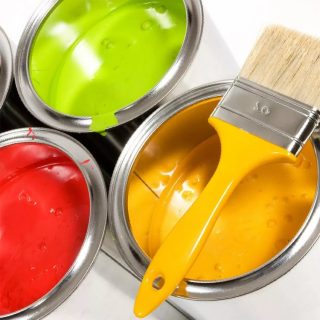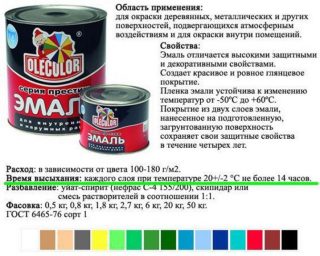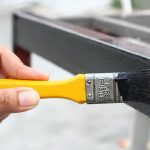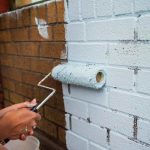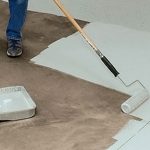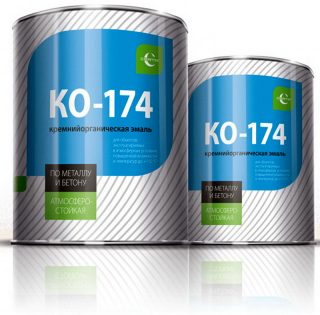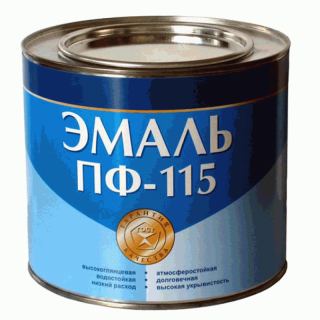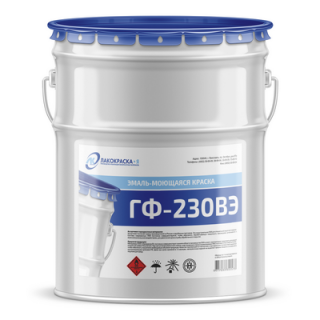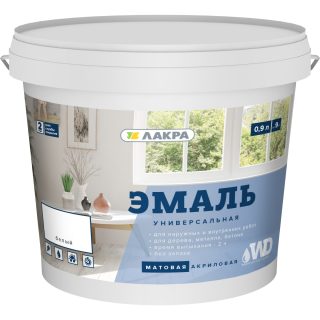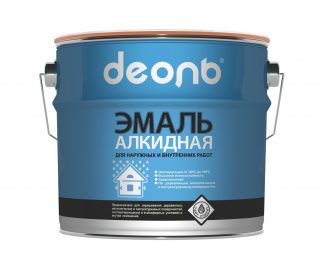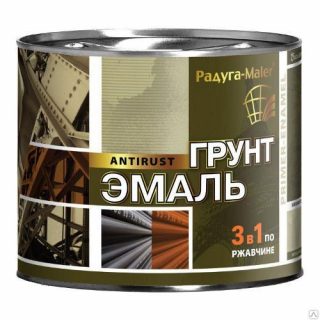Paint is a very popular finishing method. Such compositions differ greatly in properties. Of all the variety, enamel paints are distinguished by the greatest covering ability, water resistance, durability and safety.
Description and properties of paint and varnish material
Consumers usually mean coloring mixtures. Their composition may be different, but there are also common properties.
Composition and characteristics
The enamel contains 5 essential components:
- film-forming substance - varnish;
- solvent - turpentine, white alcohol, solvent;
- coloring pigments - soot, ocher, red lead, titanium dioxide;
- fillers - talc, chalk;
- modifying additives - benton, drier.
Highly flammable substances serve as a solvent in enamels. Therefore, all enamel paints are fire hazardous.
- Hiding power - the enamel forms a dense, durable, completely opaque film. Enamel paint completely hides the texture of the material - wood pattern, stone microrelief.
- Layer thickness - it is not possible to apply a thin layer of enamel even from a spray gun. But the thick coating is not afraid of scratches and minor damages. In addition, a thick layer smooths out small defects and chips.
- Wear resistance - differs in different formulations, but still noticeably exceeds the indicator of conventional paints. Enamels are used for painting even industrial concrete floors in workshops where the operating load is very high.
- Versatility - most of the compositions are suitable for painting surfaces both inside the building and outside.
A common drawback of any enamel is its limited shelf life. The closer it is to the end, the more viscous the paint becomes. You need to use the entire volume for staining.
Scope of application
All types of enamels are divided into 2 large groups.
The variant for the tree is marked in the label. Other types can be used - for concrete, brick, but not for metal. You can paint any wooden surfaces. Most often these are furniture and wooden products, less often walls or decoration. Even the roof of the house can be painted with enamel, but this option is expensive.
Universal - compositions for coloring metal and stone surfaces are combined into 1 group. Such compositions lay down in a thinner layer, but have high adhesion, since adhesion to a smooth surface is difficult. Paints of the same group are taken for staining glass and tiles, if such a need arises.
Universal enamels are used to cover brick walls, concrete floors, plastered partitions and ceilings, and glass surfaces. In outdoor work, compositions are used less often, since they have a high cost.However, for such elements as entrance doors, balconies, window frames, external stairs, they are irreplaceable.
Varieties of enamels
The characteristics and purpose of the enamel paint determines its composition. Depending on the type of solvent, fillers and pigments, mixtures are divided into paints for outdoor or indoor use, for options for metal or for concrete, for compositions that are resistant to alkalis or to the action of oils.
Nitrocellulose
Nitroenamels resistant to oils and gasoline, therefore, have been used for car painting for a long time. Paint insensitive to water and moisture, elastic, but afraid of ultraviolet radiation and high temperature... The main disadvantage is toxicity when dry, which limits the scope of use.
Nitro paint applied from a spray bottle... Its hiding power is low, and the properties of the mixture are such that it is impossible to create an even layer of enamel with a brush. The spray gun solves this problem easily.
Semi-matt or matt finish. To make it glossy, the surface needs to be polished.
Organosilicon
The main feature of organosilicon enamel is heat resistance. The paint is not afraid of heating, therefore it is used for painting automobile exhaust systems, engine parts, oil and gas pipelines. She is waterproof, therefore, it is preferred when finishing facades and metal structures operating in high humidity conditions.
Pentaphthalic and glyphthalic
Large category of paints and varnishes based on modified polyesters of phthalic acid and pentaerythritol. They produce options for both internal and external work. Therefore, when buying, you need to carefully study the labeling.
Weatherproof pentaphthalic enamels. On the street they serve up to 5 years, indoors - up to 15. Enamel forms a shiny, durable film, does not fade in the sun and is universal. However, it is more often used for painting smooth surfaces: metal, glass.
Glyphthalic differ from others in the speed of complete drying. Conventional enamels, despite the fact that they can set in 20 minutes, take up to 24 hours to cure and cure. Glyphthalic completely dry in 6 hours.
Acrylic
Acrylic compounds attract with their unpretentiousness, easy handling and low price. They are not afraid of ultraviolet radiation, are resistant to alkalis, but they do not tolerate solvents and acids well.
More often, acrylic mixtures are taken for interior decoration. They are odorless and do not emit toxic substances when dried.
The color of the dried paint is 2-3 shades darker than fresh.
Polyurethane and alkyd-urethane
During painting, protective equipment and a respirator must be used. The paint is toxic.
Alkyd-urethane color mixture is taken to cover the porch, outdoor stairs, railings. It is resistant to cold and can be painted at low temperatures.
Both enamels form a glossy shiny surface, very smooth and beautiful.
Alkyd
Alkyd paint has good adhesion and is of the generic type... But in order to extend the life of the coating, it is recommended to pre-prime the surfaces.
Primer-enamel
Primer-enamel applied only from a spray bottle... It is expensive as it replaces 3 formulations and creates a smooth shiny film.

How to choose enamel
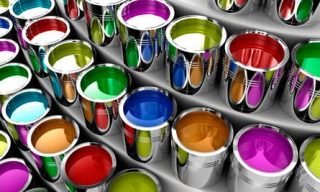
To choose the right paint, you need to determine what it is needed for, and carefully study the markings on the packaging. You need to pay attention to the following factors.
- Appointment - For work inside buildings, odorless or quick-drying paint is preferable. For outdoor work, choose a more resistant to the action of water and temperature changes.
- Load - Acrylic mix is quite suitable for the bathroom floor, for example. She is moisture resistant and beautiful. But for a museum or cinema, a polyurethane compound is required, since the load is much higher here.
- Material - for wood it is better to buy nitrocellulose paint or acrylic paint. For metal, polyurethane, acrylic, pentaphthalic is suitable.
- Shelf life - the enamel paint after the expiration date becomes viscous, loses its elasticity and water resistance. You should not take the material if the term is coming to an end, even if they offer big discounts on it.
You need to evaluate the packaging. If the tightness of the can is broken, the paint, most likely, has already lost its quality.
Application features

For enamels to show all their attractive qualities, you need to follow some rules when working.
- The surface must be cleaned: from dirt, dust, preferably from rust.
- If there are no major defects, there is no need to putty. Paint will hide minor defects.
- If the composition is intended for ceramics or metal, it is not necessary to prime the surface.
- The enamel paint can be thinned. The solvent is chosen the same as that included in the enamel composition.
The enamel is applied in 1 layer.


